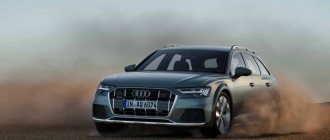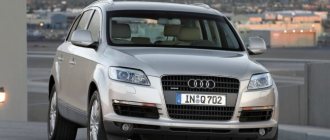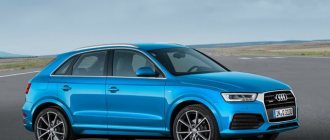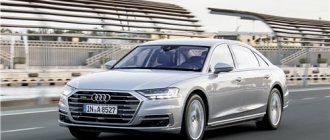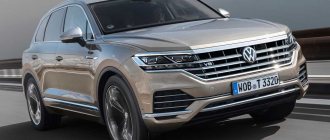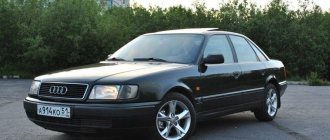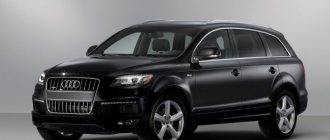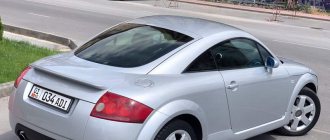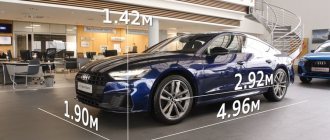Audi A4, sedan
2nd place: station wagon. You will have to overpay 70,000 rubles for the cargo-passenger orientation of the vehicle. But if you need an A4 with a remarkably convenient trunk, then the Avant is an excellent choice. In addition, on its basis there is an “Allroad” modification with all-wheel drive and ground clearance increased to 18 cm. True, by the standards of class wagons, the Avant’s trunk volume is relatively modest (490/1400 liters), so the role of such a car is an “image van” for those who want to emphasize their passion for an active lifestyle.
Pay in full
To call the A4's multi-link suspension problematic would be an exaggeration. Of course, lightweight aluminum, which provides ideal driving performance, is not the best option for our roads, but the chassis is quite capable of surviving even in Russia. Levers sometimes last more than 100 thousand km. However, the lower ball joint will make itself known by knocking much earlier.
On pre-restyling cars, the ball joint was changed along with the lever, which cost about 20,000 rubles. But then it became possible to change the lower support (4,500 rubles) separately. The service life of shock absorbers largely depends on the driver’s manners and the quality of the roads, but basically they take care of their hundred years honestly. Although knocking in the cold is a common thing for them. Electrical problems also occur in A4; there are plenty of them here, but they are not systemic or ruinous.
Restyling changed not only the interior (dashboard and center console) and exterior (LED running lights appeared in the front), but also the range of engines. Gone is the 3.2 FSI and the 160-horsepower 1.8 TFSI. They were replaced by the 3.0 TFSI and the more economical 1.8 TFSI, but with 170 hp. with start/stop system. Two new turbodiesels have also appeared. In the suspension in 2011, the mounting points of the rear levers shifted and the shock absorbers were reconfigured
To summarize, it is worth recognizing that you will have to pay in full for the pleasure of driving an A4. Service “somehow” is categorically unacceptable here. The level of technology is very high and requires only high-quality fluids and components. And they are not cheap. The choice of version is yours, but keep in mind that gasoline engines are more capricious than diesel engines, and among the transmissions, the manual transmission and tiptronic automatic are the most durable. Otherwise, there are no serious contraindications.
Which configuration?
The A4 equipment is tied to the engine. Even the base 1.8T and 2.0TDI versions are very generously equipped - perhaps the best in the class. Any car has climate control, an MP3 audio system with 8 speakers, an on-board computer, a rain sensor, rear parking sensors, electric windows and heated mirrors, an automatic parking brake, fog lights and 16-inch alloy wheels. And thanks to heated washer nozzles and heated front seats, the Audi will provide proper comfort in the cold. And, of course, all A4s are impeccable in terms of safety: ABS, ESP, 6 airbags and active front head restraints can be found in any of the “fours”.
"Audi A4"
Starting with the 2.0T engine (180 hp), the wheels will be an inch larger, cars with a 211-horsepower engine will have an advanced servotronic power steering, and the 3.0TDI, Allroad and S4 versions will have all-wheel drive. In addition, the S4 assumes the presence of sports paraphernalia in the cabin, a suspension lowered by 3 cm and wheels shod with 245/40 R18 tires.
In addition to the basic configuration, there is also an extensive (more than 140 items) list of options. What’s not in it! There are 11 types of light alloy wheels, as well as 6 types of decorative inserts, 5 types of fabric and 12 types of leather. As a result, the final specification of each specific machine depends entirely on the consumer preferences of the buyer.
What engine?
1st place: 1.8T (160 hp). Perhaps the most reasonable compromise between dynamic performance and price. Even with a full load, such a “four” retains a decent reserve of traction for overtaking and at the same time remains economical. In addition, this power unit is compatible not only with front-wheel drive, but also with all-wheel drive.
2nd place: 2.0TDI (143 hp). Diesel for 51,000 rubles. more expensive than the optimal motor. In terms of torque, it is almost as good as a gasoline V6 and even at a speed of under two hundred it will require no more than ten liters of fuel for every hundred kilometers. True, a turbodiesel is traditionally demanding on fuel quality and is more capricious when starting in the cold season.
3rd place: 1.8T (120 hp). Despite its modest power, it pulls better than many 2-liter engines. However, in a spurt, up to a hundred is two seconds behind the optimum - for a car with a sports performance, this is a lot. But if this circumstance does not bother you, then saving 100,000 rubles is a sufficient reason to choose such a modification.
4th place: 2.0T (180 hp and 211 hp). Such cars are 80 and 135 thousand rubles more expensive than the optimum, respectively. It’s worth overpaying for them only if you are very demanding on acceleration dynamics: such A4s reach a hundred a second or two faster. And one more thing - it is recommended to run these engines with expensive 98-octane gasoline.
Characteristics of the most popular models
Audi is one of today's most successful luxury brands, having effectively used its minimalist styling and Quattro all-wheel drive system to project a compelling image of modernity and innovation. Let's look at the top Audi cars - the most reliable models:
Q3
One of the most reliable models, the Q3 comes with diesel and gasoline engines. The most economical diesel has a volume of 1968 cubic meters, and the gasoline version has a volume of 1395 cubic meters. The model is available with a 6-speed automatic transmission. The Q3 model accelerates to hundreds in 8.9 seconds. Q3 is a 5-seater SUV, its length is 4388mm, width is 2019mm, wheelbase is 2603mm.
Read also Review of the Audi model range: list of new products for 2020
RS4 Avant
The RS4 Avant is a 4-door, 5-seater car. The RS4 Avant is equipped with an economical V6 engine with a volume of 2894 cc, developing power of 444 horsepower at 5700-6700 rpm. The RS4 Avant is 0.6 seconds faster than its predecessor, accelerating from 0 to 100 km/h in 4.1 seconds and reaching a top speed of 280 km/h. The RS4 Avant weighs 1745kg and the body is made of steel and aluminum.
TT RS
The TT RS is a 4-seater coupe model. The TT RS is available with two reliable and economical gasoline units - 1984 and 3189 cc, with a capacity of 227 horsepower at 4500-6200 rpm. Transmission: 6-speed automatic. The length of the car is 4177mm, width - 1832mm, wheelbase - 2505mm.
S5
The Audi S5 is a 4-seater sedan. It comes with the most economical 3.0 TFSI petrol unit with a volume of 2995cc. The model is equipped with an 8-speed automatic transmission. The body length is 4752mm, width - 1843mm, wheelbase - 2825mm. The S5 accelerates to hundreds in 4.7 seconds and reaches a top speed of 250 km/h.
R8 Spyder
The sports model R8 Spyder is a two-seater coupe. Under the hood there is one V10Plus petrol engine with a volume of 5204 cc, which develops a power of 602 horsepower with a torque of 560 Nm. The model is equipped with a 7-speed automatic transmission, accelerates to one hundred in just 3.2 seconds, and reaches a maximum speed of 330 km/h. The body length is 4426mm, width - 1940mm, wheelbase - 2650mm.
S4
The S4 is a 5-seater sedan that comes with a single 2995cc 3.0Tfsi Technology Pack petrol engine. The installation is capable of developing a power of 328 horsepower with a torque of 440 Nm. The S4 car is equipped with a 7-speed automatic transmission. The body length is 4716mm, width - 2040mm, wheelbase - 2811mm. The S4 accelerates to 100 km/h in 5.0 seconds and reaches a top speed of 250 km/h.
A7 Sportback
The sports model Audi A7 Sportback comes with one 3.0TDI diesel engine with a volume of 2967 cc. The design is capable of developing a power of 240 horsepower with a torque of 500 Nm. The A7Sportback is equipped with a 7-speed S-tronic automatic transmission. The length of the 5-seater sedan reaches 4969 mm, width - 2139 mm, wheelbase - 2914 mm. The maximum speed is 250 km/h, accelerates to hundreds in 6.3 seconds.
A4 B5
The Audi A4 B5 is a 5-seater car with a length of 4726 mm, width of 1842 mm, and a wheelbase of 2820 mm. The most reliable A4 B5 engines are the 35TDI Premium Plus diesel and the 30TFSI Premium Plus petrol unit. The diesel version has a volume of 1968 cc, the petrol version is 1395 cc. The car is equipped with a 7-speed automatic transmission. The maximum speed is 240 km/h, acceleration to hundreds in 7.7 seconds.
"Audi A4"
5th place: 3.2 l (265 hp). Engine of prestige. Usually with such an engine they buy an all-wheel drive and royally equipped car, the price of which exceeds two million rubles.
6th place: 3.0TDI (240 hp). Not the most powerful, but the most powerful. A great option for those who like to drive fast, but don’t want to stop at a gas station often. Compared to a gasoline V6, diesel is very demanding on fuel quality. But the main drawback of such a car is the price: for 1.9 million you can already take a closer look at the Audi A6.
7th place: 3.0T (333 hp). This engine is equipped with the exclusively charged version of the S4, which offers truly reactive acceleration (5.1 s to hundreds) at an exorbitant price. Taking into account the attractively varied, but extremely expensive options, the cost of such an exclusive easily reaches 3 million.
Choosing a used Audi Q7 4L: “good” and “bad” engines and gearboxes
Brakes
On heavy and powerful crossovers, the brakes are usually a very vulnerable unit. A car with a gross weight of 2,200 kg and a power of 300 hp. The braking system operates in very harsh conditions, even with relatively active traffic in city traffic. What can we say about the cases when the driver is really “burning out”... Everything is complicated by puddles on the roadway, the ubiquitous sand, the “traffic jam - gas to the floor - traffic jam” driving mode, and sometimes braking from a speed of over 200 on the highway.
Pictured: Audi Q7 3.0 TDI quattro (4L) '2009–15
Articles / Used cars Choosing a used Audi Q7 4L: body corrosion and electrical problems Are you buying a large older German car? Prepare for heavy and regular spending. If your large German car is called the first generation Audi Q7, then the amount of investment can... 9974 0 4 11/01/2016
Brake discs with a diameter of 350 mm and six-piston calipers already cope with such a load to the limit. And therefore, for those who for some reason imagine themselves driving a racing car on a two-ton crossover, among the options offered were metal-ceramic brakes , which were not afraid of such a load, although in an unheated state they did not provide normal braking, not to mention the considerable price of such a solution.
The service life of brake pads and discs is a very modest 20-30 thousand kilometers, and discs often last no longer than one set of pads. With “stepped” braking, careful and calm movement and extremely professional use of the brakes, the service life of the discs and pads increases two to three times, but most ordinary users of these cars have had and still have complaints about the service life of the brake system components.
“Incidental losses” also include failures of ABS system sensors, damage to strut wiring, air spring casings, body level sensors, and rapidly aging brake fluid. Don’t be surprised by non-original brake discs on a car with a mileage of up to 70-100 thousand, this is a completely typical case. Otherwise, there is nothing particularly to complain about. The ABS works well, complaints about excessive release of the brakes in turns and on bumps are rare, the locking pin does not cut off, because it simply does not have time to rust between disc replacements, and the parking brake turned out to be quite reliable.
Suspension and steering
The suspension of a large crossover, and even one that claims to be sporty, on wheels with “insulating tape” should also not have a long service life, even theoretically. In practice this is true. A hundred thousand kilometers, even in the city, and it’s time to rebuild the front suspension. It will require, at a minimum, replacement of the silent blocks of the lower arm and the ball joint of the upper one. And if there is an optional “pneuma”, then the price of all problems increases by an order of magnitude, and the fee for negligence (i.e. an old dryer, lack of weekly washing of air springs and checking the wiring) can amount to a significant part of the price of a car in the first years of production. It is not surprising that before restyling, Q7s often already have a “collective farm” in the form of a spring suspension instead of pneumatics or regularly go to gas stations for pumping up because the pump cannot cope with leaks or has failed.
In the photo: Front suspension and brakes. 120 thousand kilometers.
Pneumatic strut
price for original
RUB 114,377
According to some Q7 owners, the car handles better with springs, but pneumatics provide excellent comfort with quite tolerable handling, so it justifies its price. Overall, if you're looking for a cheaper Q7, I recommend considering whether you can also afford the regular suspension costs.
The steering was distinguished only by frequent rack leaks and a short service life of the steering tips, especially on cars with V8 engines and low-profile tires. This is quite expected for urban operation, with frequent turns of the steering wheel all the way and rotation of the wheels in place.
Pictured: Audi Q7 4.2 quattro (4L) '2005–09
But the cost of repairs is not comparable even with the prices for repairing suspensions and brakes, so the main risks in this case are not recognizing a leaking rack and being left without power steering, far from services. Without the help of a power steering, the steering wheel is extremely heavy - this can simply lead to an accident.
Transmission
You can't expect any special tricks from this side. The mechanical part of the transmission is very reliable, and the simplified design of the transfer case without a reduction gear only makes it stronger. CV joints, driveshafts and gearboxes are made with a good margin and can withstand everything except a 6.0 diesel engine. If they “anneal” such a motor, the shafts are literally twisted, the gearboxes are torn off the subframes, and the teeth are cut off. This is not to mention the resource of the automatic transmission.
Mechanical gearboxes, which are occasionally found with 3.6 engines and 3.0 diesel engines, do not raise any special questions, except that the resource of a dual-mass flywheel is limited to literally one hundred to one and a half hundred thousand mileage, and it costs a lot. And the clutch burns out quite quickly due to the non-optimal selection of gear ratios - the first gear is “too long”.
With automatic transmission everything is quite expected and standard. Before restyling, with diesel engines 3.0, 4.2 and most gasoline V8 4.2 engines, an Aisin TR60SN gearbox was installed, the same as can be found on the TLC 200 and the platform Cayenne and Touareg. It has fairly conservative settings and, with a calm driving style, has an impressive lifespan of 250-300 thousand kilometers by modern standards. The joy is overshadowed by the capricious hydraulic unit of the box, which is easily contaminated by wear products of the gas turbine engine locking linings during active movement, which is typical for the style of use of such machines. In addition, the automatic transmission radiator is too small, the oil regularly overheats to temperatures above 120 degrees, which increases the chances of problems occurring.
Pictured: Interior of Audi Q7 4.2 quattro (4L) '2005–09
In general, even a reliable automatic transmission cannot work a miracle, and most drivers have problems associated with twitching and delays in shifts after a run of 100-120 thousand kilometers. Fortunately, the design of this automatic transmission allows, with minimal (albeit expensive) repairs, to restore the gas turbine engine and the full functionality of the unit without mechanical breakdowns.
On cars with automatic transmission ZF 6HP21/6HP19, which were installed with 3.6 and 4.2 engines, everything is noticeably more complicated. These automatic transmissions were one of the first where the gearbox control unit was moved inside the box itself, thus obtaining a unit called “mechatronics”, and at the same time they tried to reduce the operating pressure to a minimum. It turned out to be ambiguous.
Very aggressive use of the sliding lock of the gas turbine engine, sliding switching of the main clutches, and the use of mainly linear solenoids made it possible to obtain impressive dynamics and efficiency indicators. But the integrated design turned out to be very vulnerable to contamination and overheating, and with such strict operating algorithms they simply cannot be avoided.
In general, in addition to the wear and tear of the mechatronics, the problems of which are many times more expensive than those of a “regular” valve body and control system, there is a full set of mechanical problems. Friction clutches wear out quickly due to the peculiarities of the algorithm, contamination and burning due to high temperature, problems with oil pressure, wear of box bushings, damage to drums and planetary gears appear. And of course, the resource of gas turbine engines is small, in the region of hundreds of thousands.
Pictured: Audi Q7 4.2 quattro (4L) '2005–09
To the credit of this type of transmission, they withstand the toughest starts and races for a while even better than the older Aisin transmission, but then the inevitable price comes in the form of expensive repairs and frequent failures. Moreover, in this case, five or six years is already a long time for a box; often it is already ready to undergo major repairs.
Articles / Used cars Memento mori: choosing a used BMW 5 series F10 When it comes to buying one of the BMW models, opinions are usually divided into sharply polar ones. Some repeat with a breath “ah, beemve - this is cool”, others twirl their finger at their temple and send... 92385 15 9 08/24/2016
With 6.0 engines they also installed a reinforced version of this ZF6HP32 automatic transmission, and the reinforcement was clearly not enough, because contract units are in short supply. The motor successfully “collapses” the box even at very low mileage. But the dynamics will be the envy of gasoline sports cars - this cannot be taken away.
On cars after 2011, an eight-speed ZF 8HP45 series automatic transmission with a start-stop function also appeared. Even at such a ridiculous age by “transmission” standards, it has managed to earn the reputation of being extremely unreliable, having a phenomenally short service life and, moreover, being extremely expensive and difficult to repair. Although it is worth admitting that the efficiency of the new 3.0 TFSI in combination with such a box is impressive.
For more details on the operating features of eight-speed gearboxes, see the review of the BMW 5 Series F10 ; here I will not dwell on these gearboxes in detail. Moreover, fortunately, there are relatively few cars with this combination of engine and automatic transmission.
Motors
The situation with Audi Q7 engines is ambiguous. If you want a minimum of problems, take the 3.0 TDI and 4.2 TDI diesel options - they are the most common. Quite “average” in all respects, the gasoline VR6 3.6 FSI for such a heavy car, even in the most powerful modification, was rather weak, and besides, difficulties with the chains, a not-so-successful piston and power system left no chance for trouble-free operation. But against the background of the 4.2 FSI, 3.0 TFSI petrol engine and the problems of cars with a 6.0 diesel engine, even this VR6 looks like a good boy. Below are some details.
Timing chain 3.6 lower
price for original
RUB 3,756
There are few common problems with motors. The cooling system on the Q7 was made with a reserve; only on older gasoline engines, the risk of leaks due to cracking of pipes increases with age, while diesel engines generally feel great. I have already talked about electrical problems, except that starters on diesel engines fail more often than usual, especially for some reason on restyled cars.
The “main” engine of the Q7 is a series of 3.0 V6 diesel engines in different versions. A completely successful “cast iron” has an intricate timing chain, similar to the extremely unsuccessful gasoline 4.2, but at a lower oil temperature and lower operating speeds it lasts one and a half times longer. Difficulties with injectors and the intake manifold, the presence of unsuccessful modifications of the fuel injection pump against the background of other costs for the car usually do not cause serious negativity. Moreover, the dynamics are more than decent for a “car”, and fuel consumption of up to 14-15 liters per hundred can be considered outstanding.
In the photo: Under the hood of the Audi Q7 3.0 TDI quattro (4L) '2006–09
When purchasing, you should first check the fuel filters for chips. It is believed that cars after restyling with engines with the CASA index are susceptible to misfortune, but in practice, older engines also suffer from the same disease. As a result of problems with the injection pump, the entire fuel system becomes contaminated, and replacing the “culprit” itself no longer helps. Chips from the tank will damage the next set of injectors and pump - a comprehensive replacement or cleaning is necessary.
Timing belt/fuel pump 3.0 TDI
price for original
RUB 2,045
The intake manifold on pre-restyling cars is another source of problems, but since they appeared at mileage up to 30-60 thousand, the chances of finding a car with this problem tend to zero. Well, perhaps purposefully looking for a car with minimal mileage from an owner who has not heard of recall campaigns...
There are two turbines on this diesel engine, they have a long service life, they can withstand more than 150 thousand, if you pour good oil and do not drive through puddles after “annealing” - hot “snails” simply crack when water gets in. Oil and antifreeze supply pipes require attention - corrosion, high temperature and dirt lead to leaks, and then it’s not far from the engine capital.
Diesel 4.2 essentially differs little from 3.0. The resource is even higher, although taxes will be higher. Unfortunately, the risks to the EGR system increase, and cylinder head corrosion becomes more pronounced. Well, don’t forget that an automatic transmission with such an engine is very difficult - the service life is reduced by a good third, and the chances of problems with the mechanics of the box increase.
Audi Q7 3.0 TDI quattro (4.2 TDI quattro) Claimed fuel consumption per 100 km
| Urban cycle, l | Suburban cycle, l | Mixed cycle, l |
| 8.6 l (12 l) | 6.7 l (7.6 l) | 7.4 l (9.2 l) |
In the photo: Under the hood of the Audi Q7 4.2 TDI '2007–09
The VR6 3.6 petrol is perhaps the most successful of the petrol engines. I have already mentioned the main difficulties with chains and light oil deposits, but problems with carbon deposits, injectors and fuel pumps are common for all FSI engines. The short life of the ignition modules, oil leaks and the monstrous design of the cylinder head and intake are simply a consequence of the layout decisions, and they are not serious shortcomings.
In the photo: 3.6 FSI engine (the engine compartment is prepared for repair work).
But the good service life of the piston group, low fuel consumption, maintainability of the design and ease of maintenance of the Q7 with such an engine (even compared to diesel engines!) are undoubted advantages. In some cases, a car with a 3.6 petrol engine may be even cheaper to operate than a diesel one.
The 4.2 FSI engines are a real failure. In addition to problems with power supply, there are also high chances of scuffing of the alusil piston group, difficulties with intake tightness, with the oil pump, with the oil reservoir, with timing chains, attachments and control system... The saddest thing is that the problem cannot be solved with money - even by replacing the engine with a new one , you only reduce the chances of problems occurring at low mileage. “Happy” owners of new cars with mileage up to 60 sometimes managed to replace two engines under warranty. Do you need it now, when the warranty is no longer valid, and the chances of a “kulanz” (extended warranty) are ghostly? What if the cylinder block cracks?
Articles / Practice Swap: how to change the engine to a more powerful one and not go broke Let's say you have a favorite car. Everything is fine with her, and everything suits her, except for one thing - the engine. You can’t sleep, you need someone else. But you don’t want to change your car. Or, let’s say, this model with... 58471 0 24 05/15/2015
The only case when buying a Q7 with 4.2 FSI is justified is if the engine is already dying, and the owner offers a very good discount. Having made sure that everything else is more or less in order (which is not always the case), you can buy a car specifically for a “swap” , fortunately, with relatively minor alterations, an older gasoline V8 from a Touareg or Audi A8 will fit here.
The completely new 3.0 TFSI became famous immediately. The manufacturer attributed the scuffing of the piston group to... a bad thermostat. Of course, lowering the operating temperature of the engine reduces the risk of detonation and the load on the alusil coating, but apparently, the problem was simply postponed until “after warranty.”
There were engine replacements, but most owners did not even receive an updated piston group, only firmware and a thermostat. Apart from the risk of failure, the motor looks like a miracle of modern technology. Excellent traction and power, and fuel consumption is as low as that of diesel engines, although given the difficulties with the piston engine, it is better to “feed” the AI-98 for a car with a 3.0 TFSI.
Audi Q7 3.0 TFSI quattro (4.2 FSI quattro) Claimed fuel consumption per 100 km
| Urban cycle, l | Suburban cycle, l | Mixed cycle, l |
| 14.4 l (19.5 l) | 8.5 l (10.2 l) | 10.7 l (13.6 l) |
Pictured: Audi Q7 V12 TDI quattro (4L) '2008–09
To take or not to take?
Once again the phrase comes to mind about the price of a yacht that you cannot afford. Audi's “second flagship” turned out to be very wasteful in operation, and the number of problems inherent in the design is quite significant. In the case of the Audi Q7, neither a small age nor a modest mileage, even if it is honest, guarantees a bright future. Such a car must be bought with one of the “younger” diesel engines, selected and diagnosed carefully, and still have hundreds of one and a half thousand rubles just for “expenses”. Does the amount seem significant? Then the Audi Q7 is not for you.
What transmission?
The A4 is one of the few cars in the middle class that can be purchased with all-wheel drive. However, this pleasure is not cheap: those who want to get a Quattro with an automatic transmission, so useful in Russia, will have to choose a car with at least a 211-horsepower engine, which costs more than 1.5 million. By the way, the “automatic” on all-wheel drive versions is a robotic manual transmission “S-tronic”, the additional payment for which is 70,000 rubles. On front-wheel drive cars, the role of automatic transmission is brilliantly performed by a continuously variable variator. It has smoother shifts and costs exactly the same.
